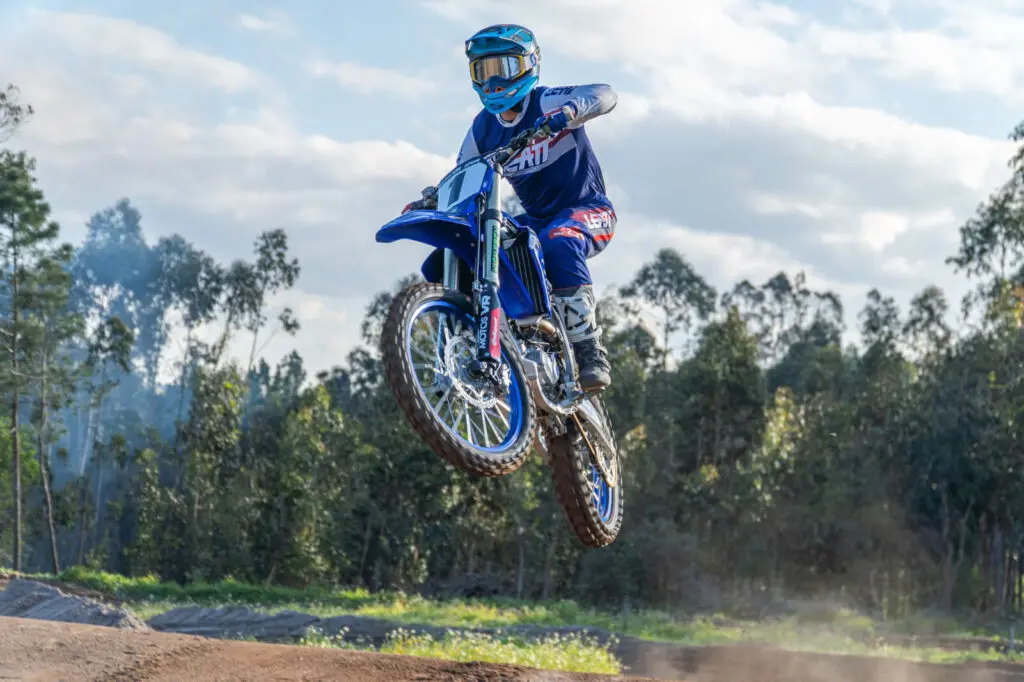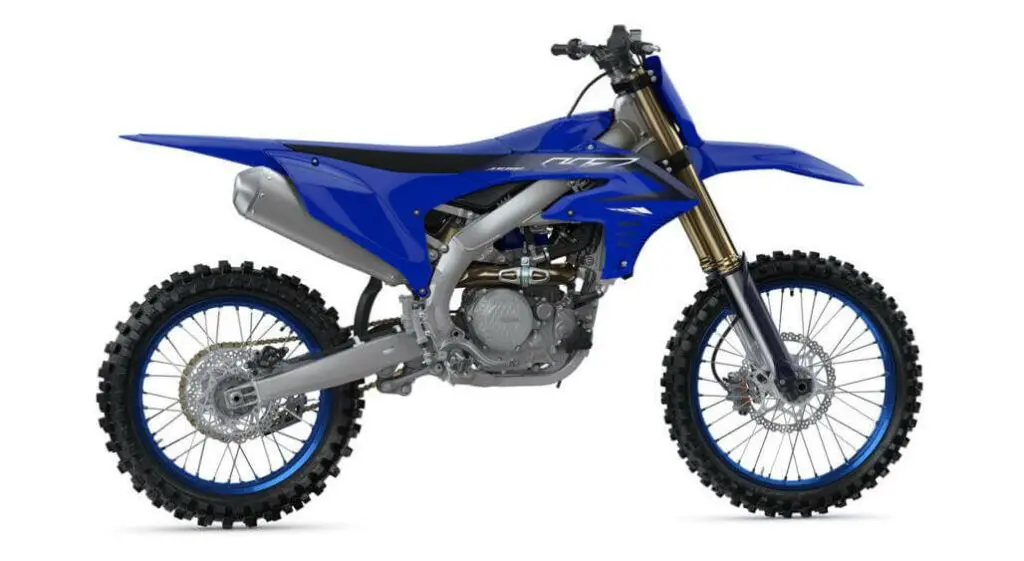As you probably already know, everything is new in this new model. Well, not everything. The wheels, brakes, suspensions, and handlebars are identical to last year, but even in the fork there are some differences. The frame is new, narrower in the knee and ankle area, lighter and with a different geometry that makes it more agile in winding areas and easier to corner. The air filter box no longer needs the old side ducts to “breathe”, so without them, all the plastics are closer to the YZ frame and structure, making it 50 mm narrower in that area. The seat is flatter, firmer, and 6 mm narrower, and also 5 mm higher. The footrests have their position moved back 5 mm and lowered by another 5 mm, which added to the 5 mm of the higher seat height results in a riding position with legs 10 mm less cramped, so we feel the cockpit more spacious.
The aluminum twin spar frame is completely new, even in the engine mounts, and the geometry is slightly different. The new bike favors a bit more agility, at the expense of so much stability (well known from Yamaha) in fast areas. The KYB suspensions are similar in all aspects except for the settings, which are different and firmer, and the compression adjusters on the top of the forks, designed to be turned by hand without a tool. The shock absorber is also similar to the 2022 one, but with firmer compression and extension settings.
STRONGER, MORE CONNECTED
Since 2010, when Yamaha introduced the engine with this intake geometry at the front and the exhaust exiting at the back, power delivery has never been the easiest to use, especially in the early years. It was always a point of improvement, but never as much as in this version. Power has increased by 5%, as well as the rev limit increasing by 500 rpm, but there were several changes that made power delivery more accessible. The head and its intake and exhaust ducts have a new design, the cylinder is new, as well as the piston, and the intake valves are larger. The connecting rod is different, without needle bearings at the base to increase reliability and the ability to handle the extra revs, and the kilogram it “lost” was mostly in moving parts like the gears of the 5-speed gearbox, crankshaft, balance shaft, camshafts, and clutch. The clutch is Austrian-inspired, with the rack and basket being a single piece made of steel, lighter and more resistant. The previous six helical springs have been replaced by a single Belleville-style spring, which basically has the shape of a large washer, and besides reducing weight, it increases efficiency, smoothness in the lever, and durability. Through GYTR, Yamaha also offers another upgrade for the clutch, in the form of an easy-to-install kit to switch to hydraulic actuation instead of cable.
The engine is smoother at lower revs, and the initial touch on the accelerator is less abrupt. Even with the standard map (we can use different injection maps, some smoother, others more aggressive) the connectivity between the accelerator and the rear wheel is brutal, making our lives easier when riding fast and even on more difficult terrain. In the middle and high rev ranges, the connectivity remains excellent, even with the maximum power values being higher than in the previous model.
ELECTRONICS AND YAMAHA POWER TUNER

The electronics play a role in the behavior of the YZ, and for 2023 there are some novelties. In addition to continuing to have the free Yamaha application, the Yamaha Power Tuner, to change injection and ignition maps, share, consult various information about our bike, tuning tips for maps and chassis/suspension behavior, this 2023 bike also has traction control. Yes, that’s right, with two intervention levels and the option to turn it off easily through the App. It also has a dedicated map for starts, which can also be configured in the App and a maximum rpm value can be set (between 6,000 rpm and 11,000 rpm) that can be adjusted in 500 rpm increments. The handlebar button is also new and allows you to activate the start map and switch between predefined maps in the App.
THE BEST EVER
In the year that Yamaha celebrates 25 years of its four-stroke MX1 bike (started with the YZ 400F), it took a huge leap forward with this new version. Upon first contact, what we immediately notice is the height of the seat, higher of course. Not only because of the seat, but also because of the firmer suspension, although on a brand new bike, like this one, the suspensions and even the frame are stiffer than usual, which only changes after a few hours of use. In the “cockpit” we notice the new button to turn off the bike/change maps, but also the higher seat compared to the handlebars. Moving on to the first 10 minutes of the film during the laps when the braking had not yet ‘bedded in’ and we were doing a semi-break-in on the YZ from Motos VR, we quickly realized that it is easy to use the new engine at low speeds, much more than the previous one. We could give little throttle and know that we were receiving little power and little rotation, which was not as linear in the old version. The power delivery is much more intuitive, a characteristic that remains when we start to ride faster on the well-maintained track of Motos VR. The track was on point and the layout is fun, but a bit short to fully explore a 450 cc, but you can still understand the new features.The suspensions are indeed firm, both in compression and extension, but I believe that with more use and opening the clicks they will become smoother. However, it is a consistent firmness, not “rough”, which allows us to attack jumps outside the landings, braking and acceleration bumps, and other difficulties with greater safety and control. The new frame also contributes to this, making the YZ’s reactions quite precise and predictable. The extra space in the riding position is welcome, even for me, who is of medium height, and rolling standing up we can more easily achieve the ideal riding position. The gearbox is quite solid and precise, and the clutch has a light and intuitive action, helping us control what goes to the rear wheel when needed, such as when the front end wants to lift too much coming out of a corner and we don’t want to cut everything on the throttle. The traction control is noticeable, but honestly we didn’t change the settings of this or the maps, as there are so many options that it would require more time. In the standard map, as we have already said, it is easy to control on the throttle but quite powerful, and it doesn’t hide when we accelerate hard in the areas that the track allows us. Power is never lacking, from low revs to the rev limiter (although we don’t benefit from reaching it), but we like the way we start to accelerate early in a tractionless corner and manage the trajectory, speed, and what the rear wheel is doing just with the right hand, which increases our confidence and speed. The braking is what we already know from Yamaha, with strong power and good feel.
It is indeed the best YZ 450F ever and, in 2023, it is certainly a candidate for bike of the year with a lot to say. Yamaha riders have been comfortable and confident in their pre-seasons, and in AMA Supercross it led Eli Tomac to win the opening round for the first time in his career, and he won a few more rounds, leading the championship as I write these lines. It is available in the usual blue decoration and in the Monster Energy decoration, and can be found at the brand’s dealerships.
YAMAHA YZ 450F

SINGLE-CYLINDER ENGINE, 4 VALVES, LIQUID COOLING
DISPLACEMENT 450 CC
POWER N.D.
TORQUE N.D.
5-SPEED GEARBOX
ALUMINUM TWIN SPAR FRAME
FUEL TANK 6.2 LITERS
FRONT SUSPENSION FULLY ADJUSTABLE KYB INVERTED TELESCOPIC FORK, 310 MM STROKE
REAR SUSPENSION FULLY ADJUSTABLE KYB MONOSHOCK, 315 MM STROKE
FRONT BRAKE 270 MM DISC
REAR BRAKE 240 MM DISC
FRONT TIRE 80/100-21
REAR TIRE 120/80-19
WHEELBASE 1,480 MM
SEAT HEIGHT 965 MM
WEIGHT 109 KG
MSRP (FROM) €10,395








